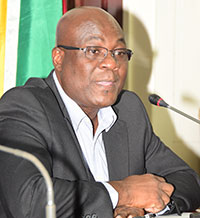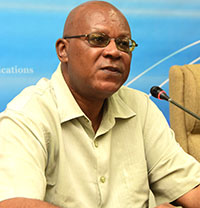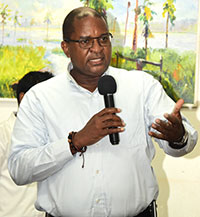IN A BID to ensure that Guyana becomes a technologically-savvy country, the Ministry of Public Telecommunications says it is ramping up programmes here to ensure that every

Guyanese becomes computer-literate.
On Thursday at the ministry’s mid-year press conference held at Colgrain House, Camp Street, subject Minister Catherine Hughes said the focus of her ministry is not only to connect communities across the country using Information Communications Technology (ICT) but to train persons to use computers and the internet.
Hughes who was appointed to the new ministry in January 2016, told reporters that the enhancement of the country’s ICT is geared at directly benefiting Guyanese, who in many instances have to play ‘catch up’ with the rest of the world. The minister noted that since the establishment of her ministry last year, “remarkable strides have put Guyana firmly on the road to national digital literacy” and she pointed to a number of initiatives that have proven beneficial to the country and the people. She said the provision of free Wi-Fi hotspots in

public places including the environs of public service locations (libraries, NIS, Post Offices, parks), the continuation of Internet connection programme at all government ministries and agencies, the full digitisation of all public services, providing connectivity in Poor and Remote communities, along with the document conversion programme, the development of a National ICT Strategy and connectivity in the education sector are all aimed at advancing Guyana to a full digitally-connected country.
Additionally, Minister Hughes believes that Guyana will develop beyond where it is once all communities across the country are ICT literate. Once done, she noted that the government would be in a better position to provide better communication, and learning facilities to its citizens.
In the case of entrepreneurship, the minister said no more would Guyana and Guyanese be

disadvantaged due to the lack of ICT facilities. Echoing Minister Hughes, Advisor to the Ministry of Public Telecommunications, Lance Hinds noted that the work of the Ministry has been placed on pillars namely that ICT must be cross-cutting in terms of production; it must make e-government more efficient and must stand alone as an economic centre that can contribute to the Gross Domestic Product (GDP) of the country.
“We want to build an ICT-ready workforce that we could go out and compete for business not only in Guyana itself but further afield,” said Hinds who disclosed that starting in August, children from across the country will be trained in varying aspects of ICT, out of which he expects there will be coders, web developers, programmers and animators to name a few.
“If we want to do offshore services and be an offshore hub, we need the numbers, we can’t go to an international client and say we want to provide this service and… tell them we have five or ten persons,” added Hinds. He said the idea is a nationwide programme which will look to quickly build the skills over six and nine months of young people. Those who are exceptional will receive additional training. “We are getting ready for a regional production hub…,” Hinds told reporters.
Meanwhile, Chairman of the National Data Management Authority (NDMA) Floyd Levi, said efforts are ongoing to extend the e-government network in the hinterland regions. So far there are seven locations in the hinterland where we have connected satellite – based internet system: Iwokrama, Annai, Karasabai, Paramakatoi, Sand Creek, St. Ignatius and Waramadong. All of these locations have secondary schools with the exception of Iwokrama which is a research centre. The aforementioned secondary schools now have the same opportunities that the secondary school students in Georgetown and along the coast have.
Additionally, the NDMA has worked with Digicel to extend its network in areas the company is located: Mabaruma, Port Kaituma, Matthews Ridge, Kwakwani, Ishalton, Bartica and Mahdia.
Eighty six schools have so far been connected to the national ICT network along with four Regional Educational Offices; six Technical/Vocational institutes and three teacher training campuses. Over the last 10 months, 55 ICT community hubs have been identified for connection in the first phase. More than 30 of them are in full operation in Regions 2, 3, 4, 5, 6 and 9, serving over 98,000 citizens with free internet.
In a bid to clarify the use of internet across the country, Levi explained that the Ministry of Public Telecommunications purchases bulk internet from the Guyana Telephone Telegraph Company (GTT) and that internet is used by government offices from 8:00h to 16:30h daily.
After the close of business at 16:30h the internet becomes dormant and is then channeled to varying communities. “It is the same internet we purchased…being used on the coast,” said the Chair of the NDMA. He said too that in the hinterland, satellites bases are set up for those communities outside of GTT.
Director of Community Development and Social Management, NDMA, Phillip Walcott, the key person responsible for the establishment of community ICT hubs, said his job is to ensure that citizens across the country are connected to the internet in keeping with the mandate given by President David Granger and subject Minister Cathy Hughes.
Walcott explained that after consulting with the Regional officials, the Neighbourhood Democratic Council and other stakeholders, the NDMA provides technical support to those identified to work along with the Authority. In addition to technical support, computers and other equipment are provided to the community hubs with the aim of empowering residents. The equipment, he quickly said remain the property of the Government.
Residents are then trained in management of the hubs, basic introduction to computers, and are helped with the creation of policies related to the managing of the hubs.
“We are providing access for all Guyanese… we want to ensure that every Guyanese is ultimately connected,” Walcott added while noting that 63 communities have been engaged thus far and the aim is to reach 406. Unfortunately, the NDMA is unable to measure the effect of the ICT hubs on each community. Walcott explained that the impact will be as a consequence of the use.
“We have to promote that to the communities,” he said adding that there are many challenges as persons are reluctant given the identifying of the project as a government project.
“We are working to remove the resistance and push for use…in the measuring of the number of people using the hubs, each community is given a target,” he stated. Targets are given Walcott said to ensure that “we are not putting down white elephants”. Supervisory visits are also done to ensure usage of the facilities.
Like Hinds, Walcott said the NDMA is in the process of rolling out a “substantial programme” across the country geared at identifying persons in communities who are in need of training. He explained that in order to benefit from ICT, persons are in need of devices and connectivity, both of which are unaffordable for many. Added to the devices and connectivity, persons are also in need of training to use the devices when made available. He disclosed that the Ministry is in the process of recruiting persons who are skilled to help the elderly understand how to use computers and the internet.



.jpg)








